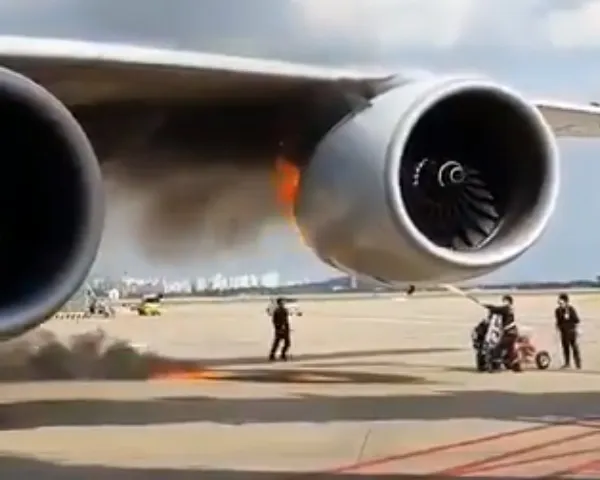
Dramatic video of Asiana A380 engine on fire
Oct 18, 2019

A dramatic video surfaced showing an Asiana Airlines A380 with one of its massive engines engulfed in flames during takeoff. The footage captures the intense moment as thick plumes of smoke and fire billow from the engine, alarming passengers and onlookers. Emergency response teams quickly mobilized, and the aircraft returned safely to the ground without major incidents. Fortunately, there were no injuries reported among the passengers or crew. The incident raised concerns about aircraft safety protocols and the airline's maintenance practices, prompting investigations into the cause of the engine failure.
The recent incident involving an Asiana Airlines A380 has captured the attention of aviation enthusiasts and safety experts alike. A dramatic video surfaced showing one of the aircraft's engines on fire, raising significant concerns regarding aircraft safety protocols and emergency response procedures. This event underscores the importance of understanding aviation safety and the implications it may have for airlines and passengers. Let's delve deeper into the details and implications of this event.
Understanding the Incident
The Asiana A380 was reportedly in the process of takeoff when the engine fire occurred. Eyewitness accounts and the shocking video depict a scene that many find alarming. As the aircraft began its ascent, flames were observed billowing from one of the engines. This type of incident is not only concerning for those on board but also poses questions regarding the safety measures implemented by airlines.
The Importance of Aircraft Safety
Aircraft safety is a multifaceted issue involving design, maintenance, and operational protocols. In the case of the Asiana A380, several factors come into play:
- "Engine Design": The A380 is equipped with advanced engine technology, but failures can still occur.
- "Maintenance Protocols": Regular checks and maintenance are crucial for ensuring the safety of commercial aircraft.
- "Pilot Training": Pilots undergo rigorous training to handle emergency situations, including engine failures.
Emergency Response Protocols
The response to an engine fire is critical. The crew's training and the protocols in place can mean the difference between a safe landing and a tragic incident. In aviation, each second counts. The following table outlines standard emergency response procedures during an engine fire:
| Step | Action |
|---|---|
| 1 | Notify the control tower immediately. |
| 2 | Initiate emergency landing protocols. |
| 3 | Communicate with passengers regarding safety procedures. |
| 4 | Prepare for potential evacuation upon landing. |
Public Reaction to the Video
The video's release has sparked a wave of reactions on social media, with many expressing shock and concern. The "dramatic nature" of the footage showcases the potential dangers of air travel. It also highlights the importance of transparent communication from airlines regarding safety incidents. Key points of public concern include:
- "Trust in Airlines": Incidents like these can undermine public trust in airline safety.
- "Regulatory Oversight": Calls for increased scrutiny and regulation of aviation safety protocols have intensified.
- "Passenger Safety": Passengers want assurance that airlines prioritize safety above all else.
Impact on Asiana Airlines
The implications for Asiana Airlines are significant. Following the incident, the airline must navigate the challenges of maintaining its reputation while ensuring the safety of its fleet. Here are a few potential impacts:
- "Reputational Damage": Negative publicity can affect customer trust and loyalty.
- "Increased Scrutiny": Regulatory bodies may impose stricter oversight and inspections.
- "Operational Changes": The airline may need to revise its safety protocols and training programs.
Conclusion: The Future of Aviation Safety
As the aviation industry continues to evolve, incidents like the Asiana A380 engine fire serve as reminders of the inherent risks involved in air travel. The need for rigorous safety measures, effective communication, and continuous training is more important than ever. For passengers, understanding the safety protocols employed by airlines can provide peace of mind when flying. The aviation industry must learn from these events to enhance safety standards and ensure that public confidence in air travel remains strong.
In light of this incident, airlines, passengers, and regulatory bodies must work collaboratively to ensure that aviation safety is prioritized. As we move forward, embracing advancements in technology and safety protocols will be crucial in preventing similar incidents and securing the future of air travel.
Related Articles

Explore Thailand: The Best Islands to Visit for Paradise, Adventure, and Relaxation

The Ultimate Guide to the Best Islands in Thailand for Your Next Getaway

Do babies need passports? How to get a passport for a newborn

How to get a U.S. passport fast: here’s how to expedite the process

What is Mobile Passport Control: 5 reasons why you should use it

SENTRI vs. Global Entry: A detailed guide

Do you need a passport to go to the Bahamas? Let’s find out

Do you need a passport to go to Mexico? A detailed guide

Do you need a passport to go to Canada? We got the answer

Do You Need a Passport for a Cruise: An Essential Travel Guide

Booster Seat Requirements: All the Rules to Follow in Your Rental Car

What Are the World’s Most Powerful Passports, and How Does Yours Rank?

How to Take a Passport Photo at Home: A Helpful Guide

You've got to have heart! Southwest's new livery

Your opinion: Should water be free on low cost carriers?

Young women bolder than guys as solo travellers
